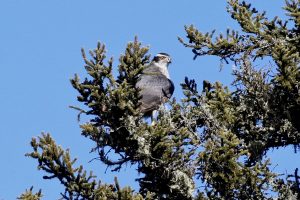(by Pam Hunt)
The goshawk is the least common of North America’s three accipiters, or “bird hawks.” In contrast to their smaller relatives, the Cooper’s and Sharp-shinned hawks, goshawks also take a significant number of mammals as prey, primarily squirrels and rabbits, and will capture birds as large as grouse. Cycles in prey populations, particularly Snowshoe Hare and Ruffed Grouse, may result in fluctuating goshawk numbers, making it hard to determine population size and trends.

That said, it appears goshawks were more widespread in New Hampshire during the 1980s, when the Breeding Bird Atlas documented breeding throughout the southeastern portion of the state. They are quite rare south of the Lakes Region today but are still found reliably in the west and north. Loss of large intact forest blocks is likely a factor in some of these local declines. To our south, goshawks have all but disappeared from historic habitat in the central Appalachians from West Virginia to Pennsylvania, and there is increasing concern about their status in this region. Habitat loss is certainly still an issue, but more recently there has been speculation on the role of West Nile Virus on populations of both goshawk and grouse in this region.
In the summer of 2025, NH Audubon will be aiding a regional effort to assess the current state of goshawks from West Virginia to Maine. Using a survey protocol originally developed for similar efforts in the Rocky Mountains and Upper Midwest, field technicians will be monitoring 100 survey units scattered across this vast geography. Each survey area encompasses roughly 1500 acres and will require biologists to walk multiple transects through the forest and periodically broadcast a recording of goshawk calls. There are 14 of these survey areas in New Hampshire, so we look forward to hearing what they contain – and how those data add up across the larger region.
These field technicians are more likely than most to experience first-hand the famous aggressiveness of a goshawk near its nest. In addition to defending their territories against other raptors, this species is well-known for attacking people who get too close. Intruders will first hear the birds’ high-pitched “ki ki ki ki ki ki ki ki ki,” and if not dissuaded, the next defense could well be a physical attack. It’s not uncommon for goshawks to fearlessly dive-bomb humans and they can even strike hard enough to draw blood.
A note on names: Until 2023, this species was known as the “Northern Goshawk” since it occurs across the temperate regions of North America and Eurasia. It turns out that there are genetic and vocal differences between the two populations, and thus they were separated into two species. Eurasian Goshawk has not been recorded in North America, although there is supposedly a vagrant record from Bermuda!
State of the Birds at a Glance:
- Habitat: Forests
- Migration: Short-distance
- Population trend: Uncertain, but possibly declining
- Threats: Habitat Loss and Fragmentation, Disease, Human Disturbance
- Conservation actions: Preserve large forest blocks
More information on “The State of New Hampshire’s Birds” is available here. Full species profiles in the format of “Bird of the Month” are now available here.
